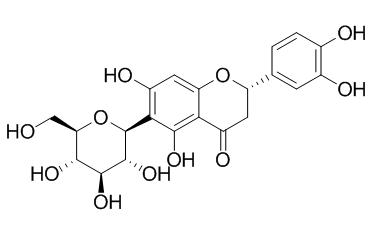Eriodictyol-6-glucoside
(S)-Eriodictyol-6-C-glucoside and (R)-eriodictyol-6-C-glucoside could
be antioxidant markers.
Inquire / Order:
manager@chemfaces.com
Technical Inquiries:
service@chemfaces.com
Tel:
+86-27-84237783
Fax:
+86-27-84254680
Address:
1 Building, No. 83, CheCheng Rd., Wuhan Economic and Technological Development Zone, Wuhan, Hubei 430056, PRC
Providing storage is as stated on the product vial and the vial is kept tightly sealed, the product can be stored for up to
24 months(2-8C).
Wherever possible, you should prepare and use solutions on the same day. However, if you need to make up stock solutions in advance, we recommend that you store the solution as aliquots in tightly sealed vials at -20C. Generally, these will be useable for up to two weeks. Before use, and prior to opening the vial we recommend that you allow your product to equilibrate to room temperature for at least 1 hour.
Need more advice on solubility, usage and handling? Please email to: service@chemfaces.com
The packaging of the product may have turned upside down during transportation, resulting in the natural compounds adhering to the neck or cap of the vial. take the vial out of its packaging and gently shake to let the compounds fall to the bottom of the vial. for liquid products, centrifuge at 200-500 RPM to gather the liquid at the bottom of the vial. try to avoid loss or contamination during handling.
Evid Based Complement Alternat Med.2019, 2019:2135351
Cells.2022, 11(8), 1311.
Food Science&Tech. Res.2022, 28(2):123-132.
Toxins (Basel).2022, 14(12):824.
J Biosci.2020, 45:46.
Food Chemistry2023, 137837.
Nanotechnology.2024, ad470d.
Industrial Crops and Products2019, 140:111612
SCOPUS.2020, 836-847.
Front Plant Sci.2021, 12: 648426.
Related and Featured Products
Journal of Chromatography A, 2014, 1366:101-109.
Modeling of the total antioxidant capacity of rooibos (Aspalathus linearis) tea infusions from chromatographic fingerprints and identification of potential antioxidant markers.[Reference:
WebLink]
METHODS AND RESULTS:
Models to predict the total antioxidant capacity (TAC) of rooibos tea infusions from their chromatographic fingerprints and peak table data (content of individual phenolic compounds), obtained using HPLC with diode array detection, were developed in order to identify potential antioxidant markers. Peak table data included the content of 12 compounds, namely phenylpyruvic acid-2-O-glucoside, aspalathin, nothofagin, isoorientin, orientin, ferulic acid, quercetin-3-O-robinobioside, vitexin, hyperoside, rutin, isovitexin and isoquercitrin. The TAC values, measured using the oxygen radical absorbance capacity (ORAC) and DPPH radical scavenging assays, could be predicted from the peak table data or the chromatographic fingerprints (prediction errors 9–12%) using partial least squares (PLS) regression. Prediction models created from samples of only two production years could additionally be used to predict the TAC of samples from another production year (prediction errors < 13%) indicating the robustness of the models in a quality control environment. Furthermore, the uninformative variable elimination (UVE)-PLS method was used to identify potential antioxidant markers for rooibos infusions.
CONCLUSIONS:
All individual phenolic compounds that were quantified were selected as informative variables, except vitexin, while UVE-PLS models developed from chromatographic fingerprints indicated additional antioxidant markers, namely (S)-eriodictyol-6-C-glucoside(Eriodictyol-6-glucoside), (R)-eriodictyol-6-C-glucoside, aspalalinin and two unidentified compounds. The potential antioxidant markers should be validated prior to use in quality control of rooibos tea.



